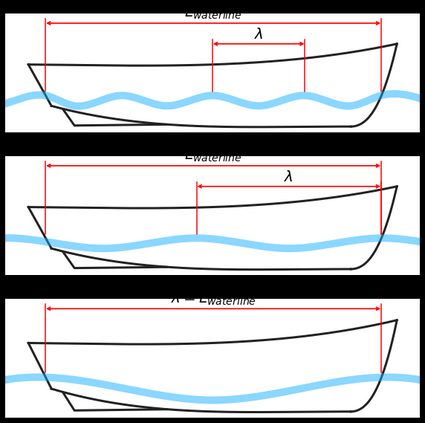Hull Speed Calculator
Welcome to the hull speed calculator. If you've ever seen a boat go so fast that its nose started rising, then you've seen the concept of hull speed in action. In this article, we'll explain what hull speed is and what it means for a ship's design. Later, we'll show you how to calculate hull speed with the hull speed formula, so that you can work out how to calculate hull speed for your own boat.
What is hull speed?
Hull speed is the speed at which a vessel with a displacement hull must travel for its waterline to be equal to its bow wave's wavelength. A displacement hull travels through water, instead of on top of it as a planing hull (like a kiteboard) would, thereby displacing water with its buoyancy as it sails. The pressure that this displacement exerts on the water creates a wave; this wave is known as the vessel's bow wave. A slow-moving boat's bow wave might make small waves, but, as the boat sails faster, the bow wave's wavelength grows. When the wavelength meets the waterline length (that's also when the bow wave's first and second crests are at opposite tips of the waterline), the boat is said to be traveling at hull speed. Take a look at the picture below to see what we mean:

Why does hull speed matter?
Although it's not perfect, hull speed remains a useful concept that can help us answer questions about how fast a sailboat can go, and the optimal amount of thrust you need to keep a boat moving forward.
A boat's hull speed limits how fast it can travel efficiently. When traveling at hull speed, the boat's bow wave and stern wave have synchronized and constructive interference occurs, which allows the boat to move very efficiently. However, at speeds greater than hull speed, a vessel's nose automatically starts rising as the vessel tries to climb its bow wave. This process is called planing, and it wastes lots of energy. Trying to move faster than the hull speed will therefore require more and more thrust (whether that comes from sails, rowing, or engines) in exchange for smaller and smaller gains in speed as more energy is wasted angling the boat upwards. Hull speed can therefore be said to impose a flat limit on how fast a sailboat can go.
Shortcomings of hull speed
Although the physics behind hull speed is sound, it is heavily dependent on the hull's shape. Long and thin hulls with piercing designs can easily break their hull speed without planing. Such hulls are found on:
- Canoes;
- Catamarans; and
- Competitive kayaks.
A hull's design can enable it to circumvent the workings of hull speed. It is for this reason that hull speed is not used in present-day ship design; naval institutions nowadays favor more modern measurements of speed-to-length ratio, such as the Froude number.
How to calculate hull speed
The formula for hull speed only needs the length of the vessel's waterline in feet, denoted as . With this length, the vessel's hull speed in knots can be calculated with
If you want to instead work out exactly how long your new boat's waterline must be for it to have a certain hull speed, you can invert the formula to obtain
How to use the hull speed calculator
The hull speed calculator is just as easy to use as the formula.
-
Enter your vessel's waterline length into the first field. This is the length of your boat's hull at the height of the waterline. Your vessel's hull speed will then be calculated and presented in the second field.
-
You can also use the hull speed calculator backward to work out how long a vessel's waterline must be if you know its hull speed.
-
You can freely change the units of your measurements without interfering with the hull speed formula.
FAQs
How can I increase my boat's hull speed without changing its hull?
Load your boat heavier! If you think about a normal displacement hull, it's usually narrower near the bottom than at the deck. So pushing it down with some weight will lengthen the boat's waterline, and so its hull speed is increased. Of course, heavier boats are harder to move, so while your loaded boat now has a higher hull speed, you would need more power to move it.